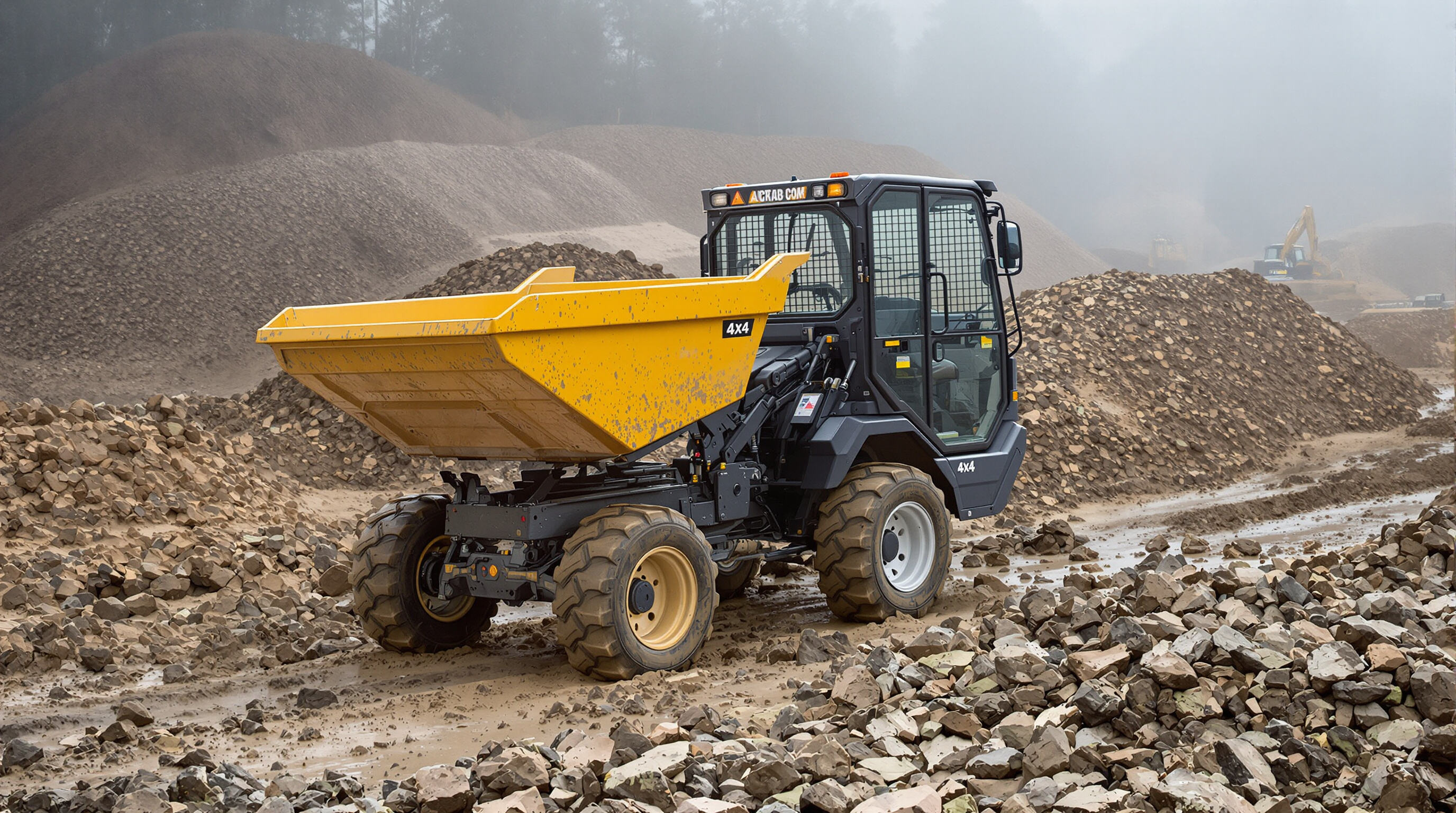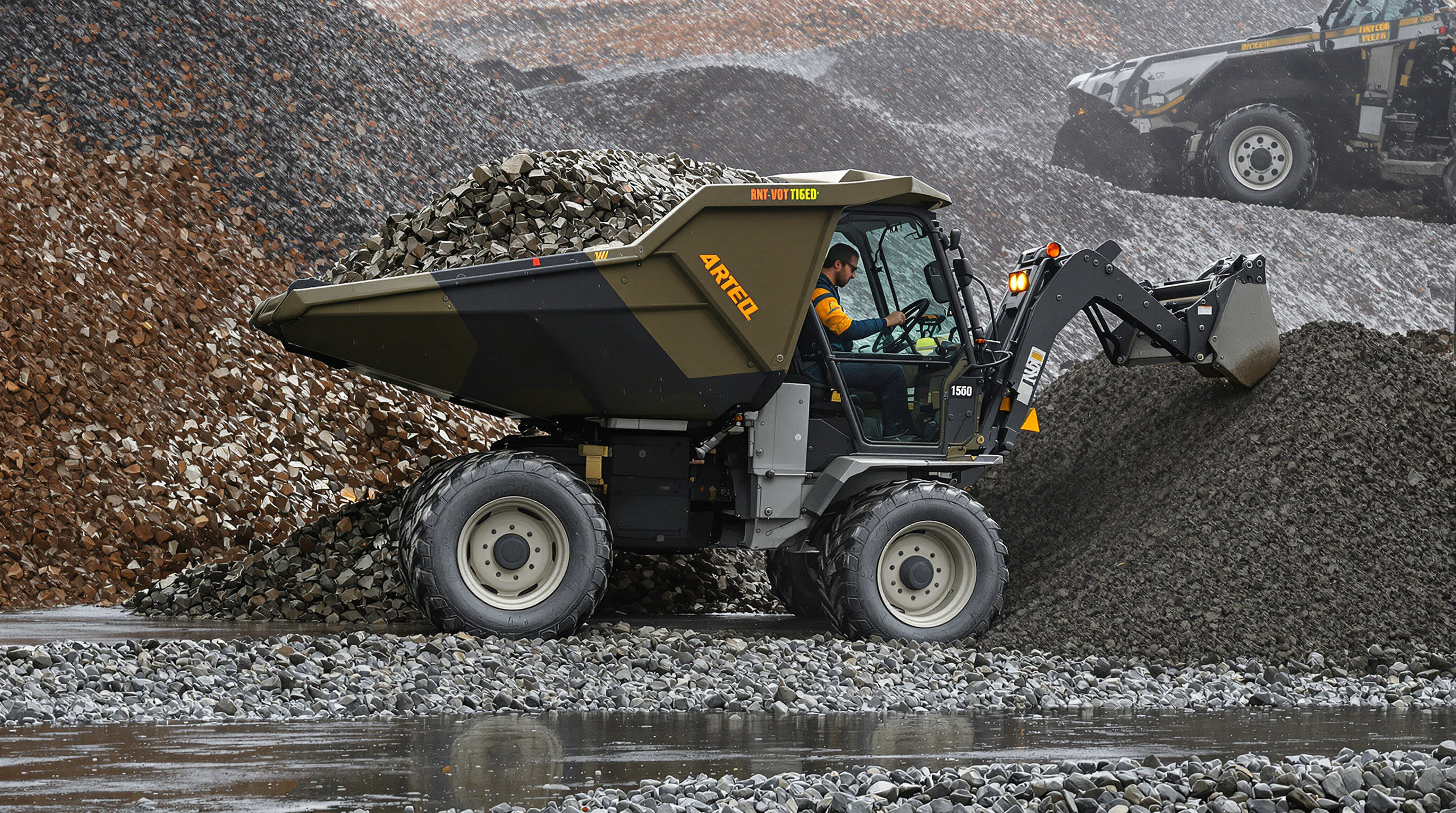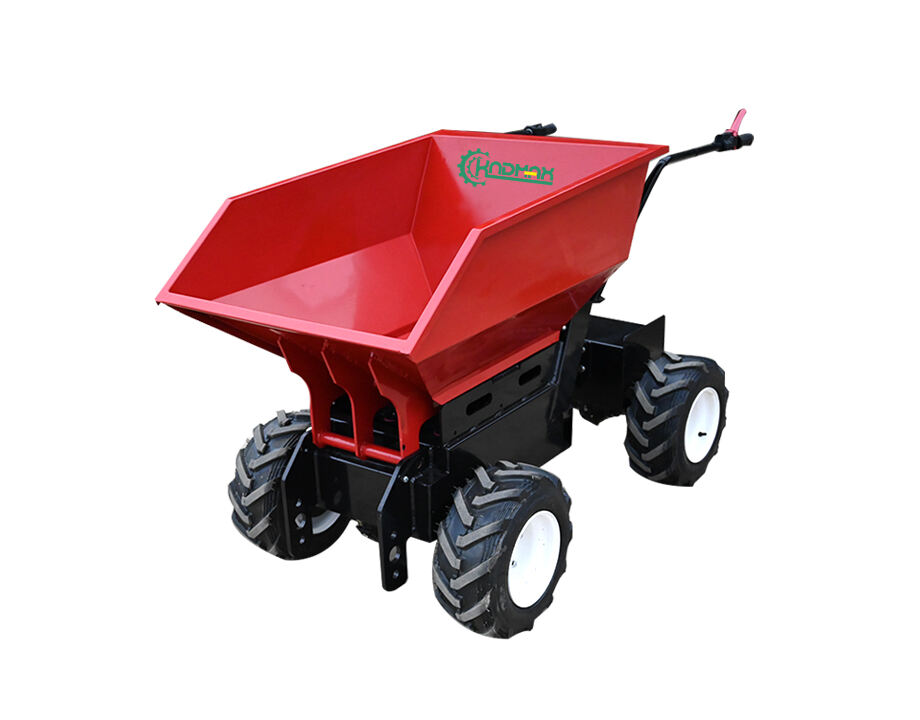The Limitations of Traditional Mini Dumpers on Rough Terrain
Common Obstacles in Off-Road Construction Environments
Mini dumpers often run into all sorts of rough terrain problems when working off road - think mud pits, gravel that shifts underfoot, hills steeper than 15 degrees, and those bumpy spots where the ground just drops away unexpectedly. All these tricky conditions make things really dangerous for operators. Wheels tend to slip around, loads shift position while moving, and whole machines can become unstable without warning. The situation gets even worse in certain areas like mountains or places prone to flooding. According to some research from the Construction Equipment Institute back in 2023, almost half (that's 42%) of all mini dumper downtime happens specifically on job sites where slopes are over 10 degrees.
Why Two-Wheel-Drive Mini Dumpers Struggle with Traction and Stability
Standard two wheel drive systems just don't cut it when it comes to distributing torque properly over tough terrain. If any single wheel starts slipping, which happens all the time on muddy ground or gravel, then power gets sent to the wrong place. The wheels just spin around while the machine struggles to maintain direction. Mini dumpers with only 2WD can't activate both front and back wheels at once like their four wheel drive cousins do. According to some research from Ponemon in 2023, this means about 23 percent less actual traction power available when going uphill. Operators end up wasting time constantly stopping and starting trying to get unstuck, which nobody wants during a busy workday.
How Poor Terrain Handling Impacts Project Efficiency
A mini dumper’s inability to maintain consistent forward motion directly increases labor costs and project timelines. Industry data shows terrain-related inefficiencies account for:
- 30% longer material transport times on rocky terrain
- 18% higher fuel consumption from wheel spin remediation
- 12% increase in manual load stabilization labor
These factors contribute to a $740/hour productivity loss on average for mid-sized earthmoving projects (Construction Equipment Institute 2023).
All-Wheel Drive Technology: Transforming Mini Dumper Performance

The Engineering Behind 4x4 Drive Systems in Compact Machines
The latest generation of 4x4 mini dumpers incorporates articulated chassis designs along with smart torque management to tackle the spatial limitations that come with smaller equipment. What makes these machines stand out is their locking differential system which keeps power flowing to every wheel, even if one starts slipping on rough terrain. According to some industry reports floating around lately, these advanced four wheel drive setups can cut down wheel slippage by about 60 something percent on gravel or dirt surfaces versus regular drivetrain configurations. The engineering behind this involves combining hydrostatic transmissions with those fancy load sensing hydraulic pumps. This setup lets the machine shift power between front and rear axles automatically, so operators don't have to fiddle with controls while navigating tricky job sites.
Enhanced Traction, Stability, and Control on Uneven Ground
4x4 technology revolutionizes mini dumper performance through three key improvements:
- Multi-surface traction: Power distribution to all wheels prevents sinkage in mud/sand
- Slope stability: 45% tighter turning radius on 15° inclines versus 2x2 models
- Load security: Automatic weight redistribution minimizes tip-overs during sharp turns
Field tests show 4x4 dumpers maintain 85%+ traction efficiency on grades exceeding 20%, compared to 48% for 2x2 variants in similar conditions. Operators report 32% fewer load adjustments needed when traversing rocky terrain.
4x4 vs. 2x2 Mini Dumpers: Real-World Performance Comparison
| Metric | 4x4 Mini Dumper | 2x2 Mini Dumper |
|---|---|---|
| Max Slope Capability | 25° sustained | 15° (with load shift) |
| Mud Traversal Time | 2.1 minutes/100m | 6.8 minutes/100m |
| Fuel Efficiency | 18L/8hr shift | 15L/8hr shift |
| Load Spills per 100h | 1.2 incidents | 9.7 incidents |
The data demonstrates 4x4 models complete terrain-intensive tasks 3.2x faster on average, despite 17% higher fuel consumption. For projects requiring daily off-road operation, the productivity gains offset increased operating costs within 18 months according to cost models.
Petrol-Powered 4x4 Mini Dumpers: Optimizing Power and Efficiency
Advantages of Petrol Engines in Off-Road Mini Dumper Applications
Petrol engines deliver immediate torque and higher power-to-weight ratios compared to electric models, making them ideal for steep inclines and rugged terrain. A 2023 Construction Equipment Journal study found petrol-powered mini dumpers outperform electric counterparts by 35% in torque output when navigating unstable ground. Key advantages include:
- Temperature resilience: Operates reliably in -20°C to 50°C environments
- Extended runtime: 8+ hours of continuous operation without refueling
- Fuel availability: 92% of remote worksites prioritize petrol accessibility over charging infrastructure
Performance Metrics of Petrol-Powered 4-Wheel-Drive Mini Dumpers

The modern petrol 4x4 machines can hit 0 to 15 km/h pretty quick even when carrying around 750 kg of cargo, which makes all the difference when moving materials around a job site. Tests out in the field show these vehicles slip about 22 percent less than regular two wheel drive models when things get really muddy. What's interesting is how the four wheel drive system actually sends about 78% more grip to wheels that start sinking into soft ground. Construction workers who have switched to these petrol powered 4x4 mini dumpers tell us they finish their cycles roughly 28% faster compared to older models, especially noticeable on those gravel filled construction sites where traction matters most.
Innovations in Engine Efficiency
One major engine maker has completely overhauled their combustion chamber design, cutting fuel usage down by around 20 percent without sacrificing the 15.6 horsepower output. They also developed this cool dual stage air filter system that actually makes engines last about 300 extra hours when running in really dusty conditions. All these improvements tackle the old problem of high petrol expenses head on. At full load, these engines now run at 8.2 liters per hour efficiency. That's pretty much on par with what diesel engines do, but with the added bonus of costing about 30% less right out of the gate for most buyers.
Superior Off-Road Capabilities for Challenging Worksite Conditions
Navigating Mud, Gravel, and Steep Inclines with All-Terrain Mini Dumpers
Mini dumpers with all wheel drive can tackle terrain where regular machines get stuck, since they send power to all four wheels which keeps them moving forward even when things get tough. According to some tests published last year in the Off Road Equipment Journal, these AWD models climb 25 degree slopes about 38 percent better than their two wheel counterparts. That means operators don't have to fight with wheelspin anymore when going over those muddy riverbanks or piles of loose gravel that used to be such a pain. The machines come equipped with different traction settings too. These settings change how much power goes where depending on what kind of ground they're on right now. Pretty important stuff actually, especially during projects where the machine might go from slick wet clay sections straight into climbing over rocks halfway through the job.
Balancing Load Capacity and Mobility Across Variable Terrain
Modern 4x4 mini dumpers achieve a 1:4.7 stability-to-payload ratio (CEA 2023 Metric Standard), safely carrying 1,200 lbs while navigating uneven ground. This is achieved through:
- Articulated suspension systems that maintain tire contact on 15" elevation changes
- Low-center gravity chassis designs that prevent rollovers on 30% side slopes
- Adaptive load-sensing hydraulics that redistribute weight during sharp turns
Operators report 47% fewer load-spillage incidents compared to rigid-frame models in forestry road applications.
Durability by Design: Features That Ensure Long-Term Reliability
Manufacturers combat worksite wear through:
- 3mm thick zinc-aluminum composite frames resisting corrosion in saltwater environments
- Dustproof bearing assemblies tested across 1,200 hours of desert operation
- Impact-absorbing polyurethane bumpers protecting critical components from rock strikes
These features contribute to a 62% reduction in unscheduled maintenance compared to standard mini dumpers (Equipment Management Quarterly 2023), with many all-terrain models achieving 8,000+ service hours before major component replacements.
Boosting Construction Efficiency with 4x4 Mini Dumper Versatility
Reducing Labor Costs and Project Timelines Through Mechanized Transport
The numbers tell quite a story about 4x4 mini dumpers cutting down on labor needs by around 40 percent when compared to dragging materials with wheelbarrows, something recent construction efficiency reports from 2023 back up pretty solidly. These machines come equipped with all wheel drive which means one person can handle moving those heavy 1 to 2 ton loads through tricky terrain like muddy ground, steep slopes, and loose gravel patches where traditionally it would take three or four workers just to get things done. Contractors who've switched over are seeing material delivery times speed up by about a quarter since these vehicles don't waste time spinning their wheels or getting bogged down. Plus there's the added benefit of fuel savings too. Most models run on petrol but they burn roughly 30% less fuel for every cubic yard transported compared to old fashioned dump trucks, making them much cheaper to operate day after day on site.
Case Study: Increased Productivity on a Mountainous Construction Site
A hydroelectric project in the Swiss Alps slashed earthmoving timelines by 35% after replacing manual crews with 4x4 mini dumpers. The machines’ 45° climbing capability and 500 kg payload capacity allowed crews to:
- Transport 80 cubic meters of rock daily across 30% inclines
- Reduce load spillage by 60% versus 2WD models
- Complete foundation work 12 days ahead of schedule
This mechanized approach saved $18,000 in labor costs while preventing weather-related delays common in high-altitude projects. The site manager noted, “Our 4x4 units became the linchpin for maintaining momentum through unpredictable terrain.”
FAQ
What are the limitations of traditional mini dumpers on rough terrain?
Traditional mini dumpers face issues such as wheel slippage, unstable loads, and overall machine instability on rough terrain, especially on slopes over 10 degrees.
Why do two-wheel-drive mini dumpers struggle with traction?
Two-wheel-drive mini dumpers struggle with traction because they cannot distribute torque adequately over tough terrain, leading to wheel spinning and decreased traction on muddy grounds.
What advantages do 4x4 mini dumpers offer over 2x2 models?
4x4 mini dumpers offer enhanced multi-surface traction, slope stability, and load security, which results in better handling of uneven ground and increased productivity compared to 2x2 models.
How do petrol-powered 4x4 mini dumpers compare to electric models in terms of performance?
Petrol-powered 4x4 mini dumpers provide significant benefits such as immediate torque, higher power-to-weight ratios, and greater temperature resilience, making them superior for off-road applications compared to electric models.
What innovations have been introduced in engine efficiency for mini dumpers?
Innovations include redesigned combustion chambers, dual stage air filters, and improved fuel efficiency, which extend engine life and reduce fuel costs for petrol-powered models without sacrificing performance.
Table of Contents
- The Limitations of Traditional Mini Dumpers on Rough Terrain
- All-Wheel Drive Technology: Transforming Mini Dumper Performance
- Petrol-Powered 4x4 Mini Dumpers: Optimizing Power and Efficiency
- Advantages of Petrol Engines in Off-Road Mini Dumper Applications
- Performance Metrics of Petrol-Powered 4-Wheel-Drive Mini Dumpers
- Innovations in Engine Efficiency
- Superior Off-Road Capabilities for Challenging Worksite Conditions
- Boosting Construction Efficiency with 4x4 Mini Dumper Versatility
-
FAQ
- What are the limitations of traditional mini dumpers on rough terrain?
- Why do two-wheel-drive mini dumpers struggle with traction?
- What advantages do 4x4 mini dumpers offer over 2x2 models?
- How do petrol-powered 4x4 mini dumpers compare to electric models in terms of performance?
- What innovations have been introduced in engine efficiency for mini dumpers?

